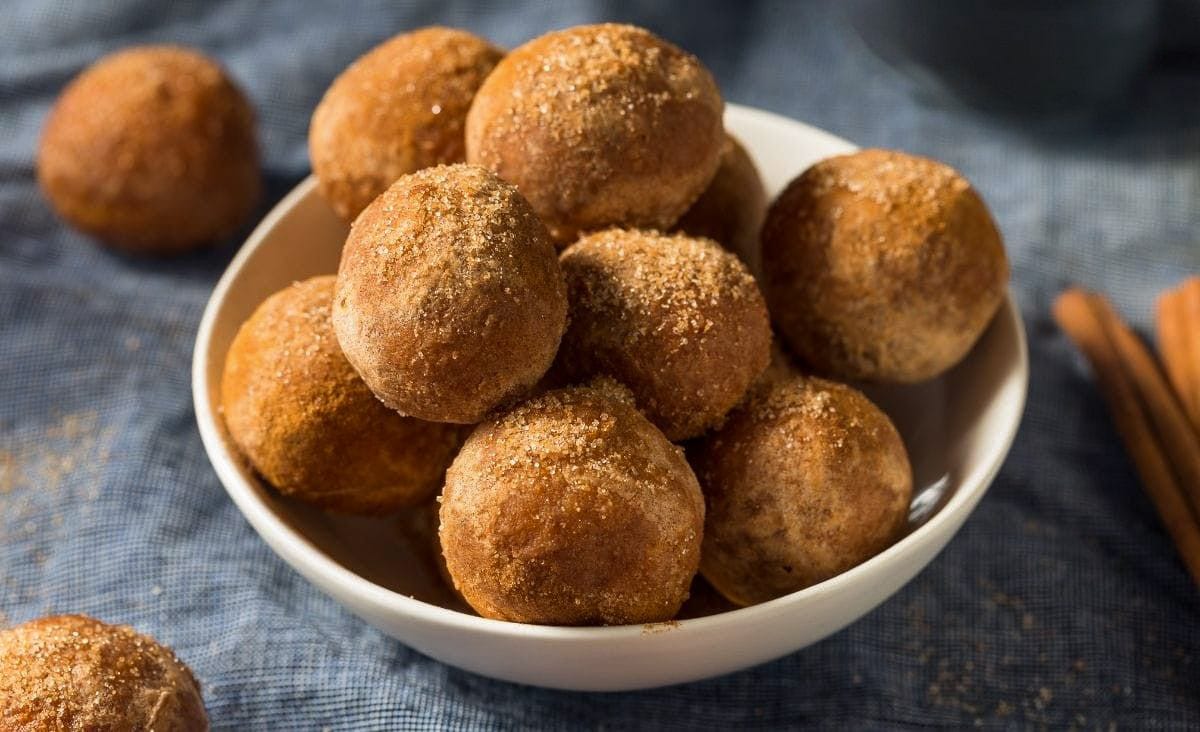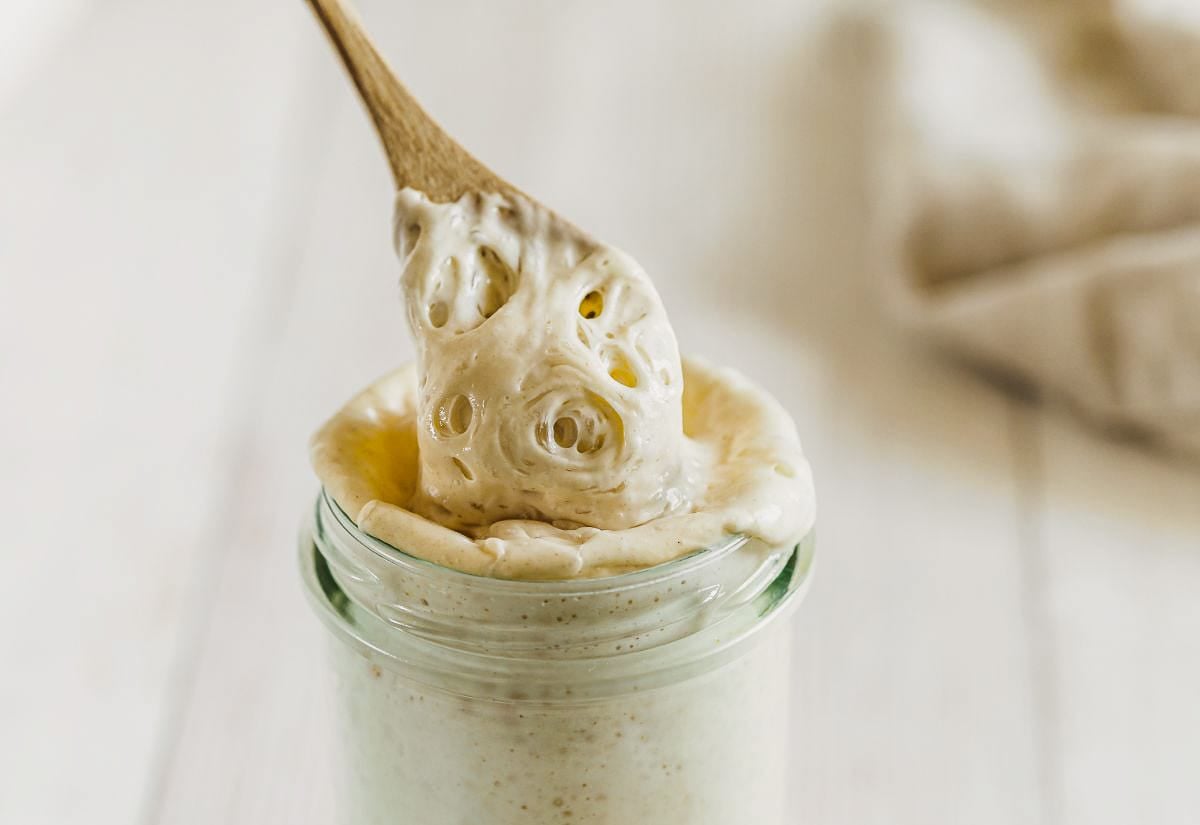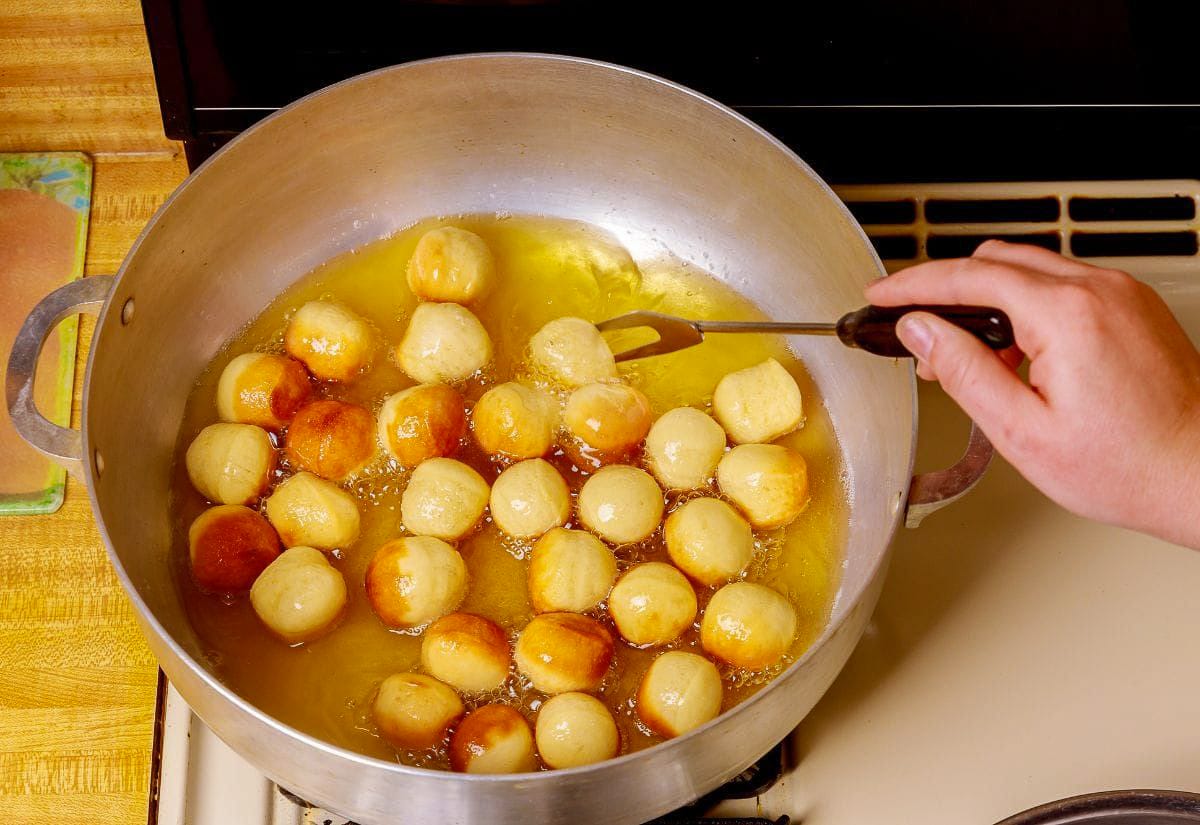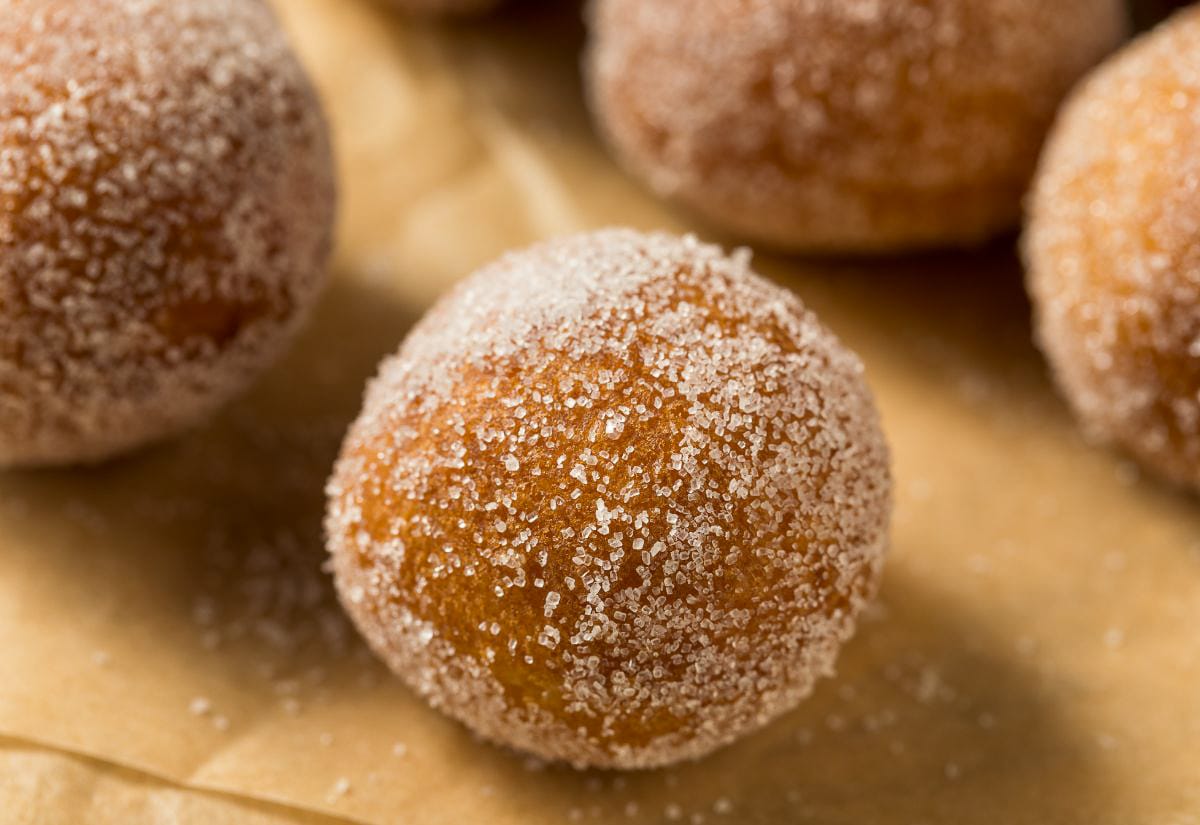Soft + Sweet Sourdough Donut Holes (with Active Starter or Discard)
Turn your sourdough starter (or discard) into delicious donut holes rolled in cinnamon sugar. This easy recipe is the perfect way to use up extra starter.

When I first realized sourdough could be used for more than just bread, it kind of blew my mind. Since then, I’ve made everything from sourdough muffins to tortillas, but these donut holes? I’ve got to say, they’re hard to beat. A warm, sugary donut made from scratch hits different, especially when it all started with a little jar of starter bubbling away on your counter.
This recipe is simple, flexible, and just plain delicious. You can use your active starter or even your discard if you don’t want to waste a thing. They’re soft inside, golden outside, and dusted in cinnamon sugar. They’re the kind of treat that disappears before you even realize how many you’ve eaten.
If you love experimenting with starter-based recipes, you’ll find plenty of inspiration in my Simply Sourdough: The Ultimate Recipe Roundup, which collects all my favorite ways to use it beyond bread.
Why You’ll Love Making Sourdough Donut Holes
Sourdough adds a little tang that keeps them from being too sweet. That balance is what makes them so good. The long fermentation gives them a soft, slightly chewy middle and keeps the crust crisp and golden. They’re pretty forgiving too. Use active starter for a lighter rise or discard for something a little more cake-like. Both turn out great.
If you’re still figuring out how to keep your starter happy (or you just forget to feed it sometimes — been there), my Sourdough Starter Log & Care Guide makes it way easier.
What You’ll Need
You won’t need anything complicated to make these sourdough donut holes. Just your usual baking basics and a happy starter.
Use a good-quality all-purpose or bread flour for structure, and any milk you have on hand to bring the dough together. Whole milk adds a little extra richness.

A bubbly, active starter gives you light, airy donuts. If you’re using discard instead, they’ll be a little denser and more cake-like. Just add a pinch of baking powder to help them puff up.
When it’s time to fry, use a fresh, neutral oil that can handle the heat. Canola or peanut oil both work great.
How to Make Sourdough Donut Holes
Once you’ve got your ingredients ready, the rest is easy. You’re just a few steps away from warm, cinnamon-sugar goodness.
Mix It Up and Give It a Quick Knead
Start by warming your milk until it’s just comfortable to the touch. Not hot, just enough to take the chill off. In a large mixing bowl, combine the flour, sugar, salt, egg, milk, and sourdough starter. I usually grab a wooden spoon for this part and mix until everything comes together into a soft dough that pulls away from the sides of the bowl. It should feel slightly tacky but not sticky.

Once the dough starts to hold together, turn it out onto a floured surface and give it a quick knead. Just a few minutes until it feels smooth and elastic. Overworking the dough can make the donut holes tough, so stop once it feels springy and easy to handle. If you’re using discard instead of active starter, the dough may feel a bit denser, but that’s perfectly fine.
Shape and Let Rise
Next comes shaping. Divide the dough into small, roughly even pieces (about the size of a large walnut) then roll each one between your palms into a ball. They don’t have to be perfect; the slightly uneven ones usually end up with the best texture. If you prefer traditional donuts, you can roll the dough into ropes and pinch the ends together to form rings, but I find donut holes easier and just as satisfying.
Once shaped, place the dough balls on a parchment-lined baking sheet, leaving a little space between them. They’ll need a warm, cozy spot to rise for about an hour. If your kitchen runs cool (and mine usually does in fall), warm the oven for a minute, turn it off, and set the tray inside with a bowl of steaming water. The dough won’t double, and that’s okay. They’ll puff beautifully once they hit the oil.
Fry and Coat in Cinnamon Sugar
While they rise, mix together your cinnamon sugar for rolling and set up your frying station. Pour oil into a deep pot or fryer, enough to let the donuts float freely, and warm it to around 330°F. I like to use a simple thermometer to keep an eye on it. Too cool and the donuts soak up oil, too hot and they brown before cooking through.

When the oil’s ready, drop in a few donut holes at a time. They’ll sink first, then rise as they cook. Give them a gentle flip with a slotted spoon once the bottoms turn golden. It usually takes about three minutes per side, but go by color rather than time. When they’re evenly golden brown, lift them out and let them drain for a few moments before rolling them through the cinnamon sugar.
The smell at this point is reason enough to make them. Everything about it says fall. Try to resist eating them all right away, but I won’t blame you if you can’t. They’re best warm, and in my house, they never make it to the next morning.

Storing (If You Somehow Have Leftovers)
On the off chance you’ve got a few left, store them in an airtight container so they don’t dry out. Once the donut holes have cooled completely, tuck them into an airtight container to keep them from drying out. They’ll stay soft for a couple of days at room temperature or up to three days in the fridge.
Reheating Tips
When you’re ready to bring them back to life, a quick reheat in the oven does wonders. Set it to 300°F and warm them for about ten minutes. It brings back that crisp edge and soft center (pretty close to fresh from the fryer). If you’re short on time, the microwave works for a quick fix (ten or fifteen seconds is plenty) though the texture won’t be quite as crisp.
How to Freeze
For longer storage, you can freeze them. Lay the cooled donut holes out on a baking sheet and freeze until solid, then move them to a freezer-safe bag or container. That way, they won’t stick together, and you can grab just a few at a time. To reheat, skip the thawing and go straight to the oven. Just give them a couple of extra minutes.
They’re best warm and freshly sugared, but even from the freezer, they make a pretty great surprise on a cold morning, especially with a mug of homemade hot chocolate. It’s one of my go-to winter pairings.
Questions About Making Sourdough Donut Holes?
You’re not the only one. These are the questions I get most often.
Got extra starter? Pin this recipe now so you can turn it into a batch of warm, sugary sourdough donuts later.

There’s something so satisfying about turning a little sourdough starter into a plate of warm, cinnamon-sugar donuts. It’s pure comfort and a nice reminder that sourdough can be so much more than just bread.
So go ahead, feed your starter, warm up the oil, and make yourself a batch. Trust me, your kitchen’s about to smell amazing.

Cinnamon Sugar Sourdough Donuts
This post may contain paid links. If you make a purchase using the links in this recipe, I may earn a commission.
Ingredients
- 2 cups White Flour
- ½ cup Milk
- ½ cup Active Sourdough Starter
- ¼ cup White Sugar
- 1 Egg
- 1 tsp. Salt
- Oil or Fat for frying
Instructions
- Heat milk in a small pot until it’s warm to the touch but not hot (just slightly warmer than room temperature).
- In a large bowl, combine flour, sugar, salt, egg, milk, and sourdough starter. Stir with a wooden spoon until the dough comes together. It should feel soft and slightly tacky but not sticky.2 cups White Flour, 1/2 cup Active Sourdough Starter, 1/4 cup White Sugar, 1 Egg, 1 tsp. Salt, 1/2 cup Milk
- Turn the dough onto a floured surface and knead for about 3–5 minutes, just until smooth and elastic. Don’t overwork it. A gentle knead is all it needs.
- Divide the dough into 24 even pieces (or 12 for donuts). Roll each piece into a ball for donut holes, or shape into ropes and pinch the ends together for traditional donuts. Place on a parchment-lined baking sheet with a little space between each.
- Cover and place in a warm spot to rise for about 1 hour, or until slightly puffy. If your kitchen is cool, you can warm the oven briefly (then turn it off) and set the tray inside with a small bowl of hot water to create steam.
- In a small bowl, mix sugar and cinnamon for rolling. Set aside.1/2 cup Sugar, 1/2 tsp. Cinnamon
- Pour oil into a deep fryer or heavy-bottomed pot to a depth of about 2 inches. Heat to 330°F. Keep a close eye on the temperature . Too hot and the donuts will brown too fast; too cool and they’ll soak up oil.Oil or Fat
- Carefully lower 4–6 donut holes into the oil at a time. They’ll sink at first, then float as they cook. Fry for about 2–3 minutes per side, turning with a slotted spoon once the bottoms turn golden brown.
- Remove from oil, drain briefly on paper towels, and while still warm, roll in the cinnamon sugar mixture until evenly coated.
Notes
- These donuts are best the day they’re made, but they’ll stay soft for 2–3 days in an airtight container.
- To reheat, warm them in a 300°F oven for about 10 minutes to restore that crisp edge.
- For longer storage, freeze cooled donuts in a single layer, then transfer to a freezer-safe bag. Reheat directly from frozen for 12–14 minutes at 300°F.

dough is really sticky, had to wet my hands to work with it. too dense for donuts, ended up using for garlic parm bites instead.
You did the right thing with wet hands. It’s a soft dough by design. If it turned out dense, try letting it rise a little longer next time. Garlic parm bites sound like a great save, though!
These were chewy and could do with maybe longer proof time or yeast to make more airy. It was a very wet dough and agree that oiling hands may help. Also added more cinnamon to the sugar for better flavor. Definitely needs more tweaking, but a nice recipe for a somewhat quick donut treat.
Just tried this recipe tonight. Workes great, but I made. a couple tweeks.
Mix all ingredients until combined and let rest for 30min towel covered. Do not mix on floured surface, but mix in bowl. If it is still too sticky to make into balls, use oiled hands to work the dough and let it rest again. Was easy to work with after this! I let the 24 balls rest for 8hr before frying.
They ended up about 2xs the size of donut holes and would consider making 48 smaller donuts next time.
Used 113 gram starter.
Can they be baked or airfried?
Any chance you can add the ingredients by weight?
These came out tough and chewy.
This is useless. I’ve baked with sourdough for 20 years, and know how a “revived sourdough starter looks, and this simply does not work. I should have known better than to trust a recipe with ingredients in volume. Avoid! Or add yeast.
Warm with caramel and ice cream? You betcha!